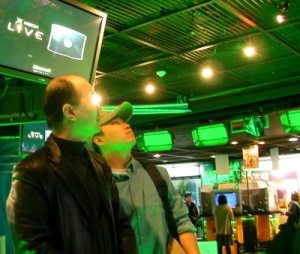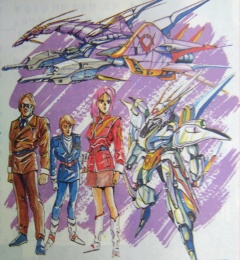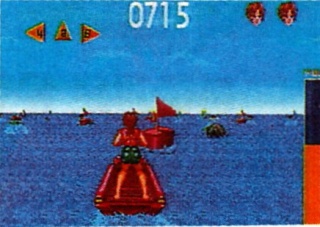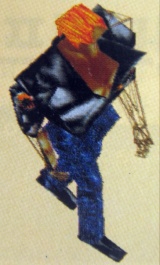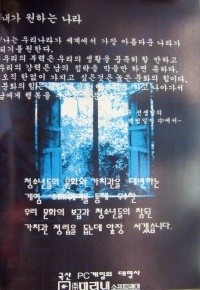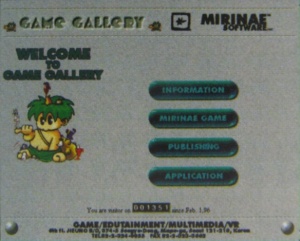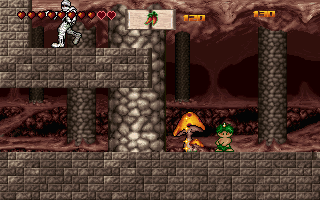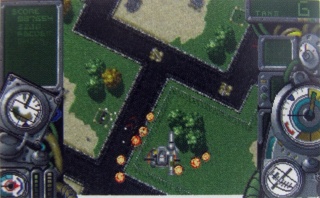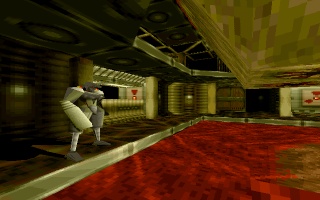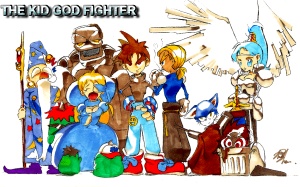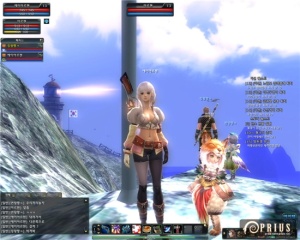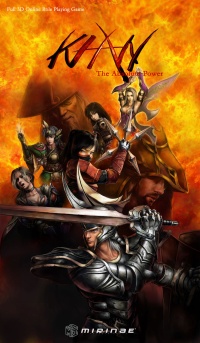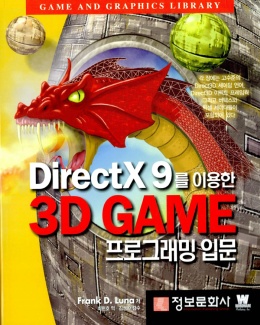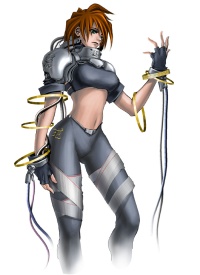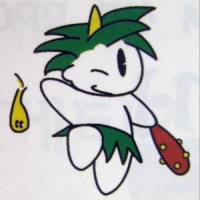A History of Korean Gaming
|
Next Page >>> |
|
Mirinae: |

The Legacy of Mirinae Software: Interview with Kim Kyongsoo and Kim Seongwan
Readers of the first part of our big series on Korean video game history might have noticed that none of the developers covered there can be found today. When naming representative and deeply-rooted companies like Softmax, Gravity or Nexon, it soon becomes clear that none of them reaches farther back than 1994, at least when it comes to measurable public activity. The one name that really was identified with Korean games on the southern part of the peninsula for the good part of the 1990s was Mirinae Software.
In rough times of financial crisis and big changes in the industry, though, the industry's former flagship sank, almost suddenly from a gamers' perspective. The name re-appeared in the early 21st century, but never managed to recover its former status and disappeared again, barely leaving any trace at all. At least so it seems, but in actuality Mirinae's legacy continues until today. Former staff of Mirinae Software have since been involved in the first FPS game from the country as well as its first fully 3D avatar community. Most publicly recognized was Kim Namjoons founding of Webzen, one of Korea's big online game publishers of international success. But since Mirinae's former president seems to have been all but disappeared together with his company (one is inclined to reminisce upon the proverbial captain that goes down with his ship), Mirinae itself remains mostly a mystery to onlookers from the present. Well until now, as we have reached two former employees who took the time to enlighten us not only about the company itself but also the greater environment in which its rise and fall took place, as well as their work post-Mirinae.
Kim Kyongsoo was the game designer for most installments of the famous The Day series, but directed games also in various other genres, like the RPG The Romance of Forgotten Kingdom, the platformer Eracha, the mecha simulation Battle Gear and the casual fighting game Kid God Fighters. Later he joined Jamie System, where he created Xtom 3D and Axis, the aforementioned first Korean FPS proper. Since then he has been involved with a lot of undisclosed and unreleased MMO titles at NCSoft, Wemade and Ntreev before his latest project at CJ Internet Games, Prius Online, met a more fortunate fate and is currently running in public beta (recently rebranded as Blood Anima). Among his works Eracha, X-Tom 3D and Axis have been published in various Western countries.
After graduating in physics at Sogang University, Kim Seongwan began work at Mirinae as an assistant programmer, but soon worked up the ranks and became responsible for the 3D technologies which Mirinae pioneered in among Korean developers, reaching from sprite based effects in The Day 5, Izmir and Full Metal Jacket to the country's first versatile 3D graphics engine, Real 3D, which was used in Armageddon, Battle Gear and Necrons. He also worked on several unreleased games from 1997 to 2003, but since then devoted himself wholly to the sector of game programming education and became a professor at the Busan Game academy. He also entertains a long-running homepage at g-matrix.pe.kr, with essays on game development reaching back as far as 1993.
When exactly did you join Mirinae Software?
Kim Seongwan: I have worked at Mirinae Software for about three and a half years, from November 1993 to March 1997.
Kim Kyongsoo: I started developing games part time at Mirinae in 1988.
When you joined in 1988, that was very close to the beginning, right? How many members were at Mirinae at that time? Known as the founding members of the team are Cho Daeho, Yang Jaeyoung and Jeong Jaesung, how many worked on your first released game, The Day II?
KKS: Besides the three you've mentioned, there was just me, so four people. Cho Daeho was responsible for the marketing, Yang Jaeyoung and Jeong Jaesung were Programmers and I did the game design and graphics. That was my job for The Day II and III, as well as Defender of Freedom. Towards the end of the development of The Day III I had to go to the military, so I think others came to fill in for the final development stages.
So was there no extra staff for the music in The Day II? The style does sound very different from later Mirinae games...
KKS: I don't know who did the music for The Day 2. I was still in high school at the time and did most of the work at home, so I've never met any composer for the game.
The Day II was the first commercially released game by Mirinae, while the first in the series was cancelled, reportedly due to problems with the scrolling code. Why drop the entire game instead of fixing the problems?
KKS: I wouldn't know the exact reasons, but I think there were several problems with the game that made it more viable to just reboot the project instead of just fixing them.
The old Mirinae homepage listed a bunch of other titles like Star Tale, The Temple of Heavenly Sphere, Assault Gear, Venturaiders, Landst and Rune Blade, but there's no further information to be found on those. Are those all unreleased games?
KKS: Those titles are all games I've drawn concept sketches for during my highschool days, but they've never been in actual production. You can regard them as nonexistent.
So it seems you've wanted to make games since very early on. Were there any games in particular that inspired you to become a game designer?
KKS: Back when I first got to know Game Centers as a kid, I already dreamt about becoming a game developer. But at the time there weren't any proper game development companies in Korea, so I couldn't even imagine how to get started and get a job in the video game business. I think it was a great opportunity for me to have found Mirinae Software. At the beginning, when home computers first started to get more widespread, it was mostly Apple and MSX compatibles, and it seems aspiring game developers were mostly influenced by which machine they first owned. So I guess Apple users like Nam Inhwan, whose Sin'geom-ui Jeonseol is also covered in your article, were greatly influenced by Richard Garriot's Ultima series. I myself first owned an MSX computer and was particularly impressed with Falcom's Ys series. I think I was also influenced a lot by Final Fantasy (Although I personally don't like the sequels after Final Fantasy VI, anymore).
The soundtrack for The Day 3 was only credited with the pseudonym "Odin". Do you remember who was behind that name?
KKS: That was Moon Deukgee, his nick used to be theOdin. He worked also for a lot of other companies, his latest project that I know of was as the director of the Priston Tale online game series.
Professor Kim Seongwan, your homepage mentions two freeware games you've made before joining Mirinae, Fighter 7 and Thunder. Do these games still exist today?
KSW: Fighter 7 and Thunder are essentially the same game. I've renamed it to Thunder when I made the version for upload on HiTel. Thunder still exists.
Around 1994 the company got divided into Mirinae Software and Sailon Software. What were the reasons for that. Super Samtong was originally in development at Mirinae, but finally released by Sailon. How was the relationship between the two companies then?
KSW: That divide took place immediately before I joined in 1993. I think President Jeong Jaesung and section chief Yang Jaeyoung had some differences. I heard the agreement was that Yang Jaeyoung would take the majority of the previous staff to Sailon, while Jeong Jaesung kept the Mirinae name.
You've made also a couple of games for the KBS Game Paradise TV program. Where those made to be played from people's homes by phone or played in the studio?
KSW: Yeah, those were played by calling in to the show and using the buttons of your phone. So of course it was live. That show was really a pain to set up.
Mirinae was one of the founding members of the Korean Game Developer's Association, KOGA. I know that KOGA founded a publishing company in 1997, but what was the role of KOGA before that?
KSW: It didn't play too big a role. You could compare the KOGA publishing company to the Gathering of Developers in the US. It was meant as a publisher that stood for the interests of developers, but just like with GOD it proved difficult to realize that ideal.
When looking through old Korean gaming magazines, there are mentions of a game titled Nambeol every once in a while, from 1994 all the way to Mirinae Software's final days in 1997, but information is alway very sparse. Was the game in development all the time?
KSW: Mirinae had developed the game adaption of Armageddon by Lee Hyunse, who was then the most popular manhwa artist in Korea. At the time Mr. Lee Hyunse became also a shareholder of Mirinae and the company got the rights to adapt his comics. One of them was Nambeol. If I remember right, it was only in the concept stage and never entered actual production. So in the end the only game that came out of that deal was Armageddon.
In the mid-90s, Mirinae casually announced that they would start to develop "rompack games". Did the company ever start any games for consoles?
KKS: There were plans to make games for SNES and Sega Genesis, but getting a third party licence by Nintendo or Sega wasn't easy, so nothing came out of this.
Some of Mirinae's advertisements tried to appeal to the customers' patriotism. To what degree did that have a pull with gamers? You've also made some games based on Korean history and folk tales like The Romance of Forgotten Kingdom and Namukkun Iyagi. Could scenarios like that catch gamer's interest in particular?
KSW: The influence of patriotism was negligible.
KKS: Everyone here would like games about Korean history or folklore. But unfortunately there isn't much material in Korean tradition that is as predestined for games like Western fantasy, Chinese Wuxia or Japanese samurai and ninja.
KSW: Back then the Super Nintendo was considered as the best, so Japanese games were the most popular, while the response to Korean games wasn't all that enthusiastic.
I've read that the Scenario for The Romance of Forgotten Kingdom originally came from a prize winner at a government game scenario writing competition, how did Mirinae come to adapt the script? Did the Author Ryoo Jaeyong also take part in the game development?
KKS: Aside from delivering the original script, he wasn't involved. Since a scenario written on paper cannot really reflect the author's intention for a game, there's a lot of differences between the original script and the actual game scenario.
I also read about a network client for The Romance of Forgotten Kingdom. What functions did that client have?
KKS: Professor Kim Seongwan should know more about that client. Since we didn't consider network functions when designing the game, I can't imagine it could have done too much.
KSW: I don't remember the exact details, but that was meant to experiment for online multiplay. Of course that was only a test, I don't remember if [the company] had any plans to make an online version of the game, but at any rate there was none that went online.
Actually, Mirinae Software also had a web presence before most Japanese companies, and was preparing online games. We also had developed a general networks client program called "Doran Doran". Mirinae's Online game development team later became Pantech Net. Of course, they weren't that successful on the market. The deciding factor that lead early online game developers like Nexon and NC Soft to success on the market was, in my view, the fact that developers who had a decent experience in playing and developing MUDs now were making online games. I think experienced retail PC game developers like Mirinae used to underestimate online games. Like they thought everything would turn out well if they just added network functions to finished retail games.
By the way, I don't know if you're interested, but the game is currently being fan translated. You can see some WIP screenshots here. (The translation patch has since been released. -ed.)
KKS: There's no way I could be not interested in this! I have to say, I'm honored.
In your game Eracha some employees of Makkoya, like the president Hong Donghee appeared under "Special Thanks" in the credits. What was their involvement with the game?
KKS: At the time there weren't that many developers out there and it wasn't as easy as today to get materials over the internet to aid with the development, so there were a lot of instances where companies exchanged their know-how.
Speaking of Eracha, how did you get the idea for the protagonist to create mushrooms by peeing?
KKS: That idea came while we were thinking about a way to animate how the goblin character could create the trampoline mushrooms on the map where he needed them. So we thought his urine could be used as a fertilizer, and it would fit his character well to show him blushing in shame after exposing himself.^^
Professor, you've been a programmer most of the time, but you were also the director of Full Metal Jacket, right? There was this game called BTN 2 (Bring the Noise 2) by Atto Entertainment also in development in late 1995 which never came out, but it looked almost just like Full Metal Jacket. Was there any connection between the two games?
KSW: The games were originally developed without us knowing about each other. Atto Entertainment once held an industry event where they revealed the game, that was when I first saw it, and I was also quite shocked. They had the same type of game and it seemed they already had progressed much further than us. But there arised problems at Atto Entertainment, and the game wasn't released, while Full Metal Jacket made it. Later I heard there was supposedly a break-in at Atto Entertainment and the computers they used to develop the game were stolen.
Mirinae was among the first companies in Korea that came up with their own polygonal 3D technology. Was it difficult at the time to get the necessary know-how for that?
KSW: Personally, I've started around the time when I graduated from high school in 1984 to slowly study about 3D graphic programming. There weren't any educational institutes and I had to learn everything on my own. My most important role back at Mirinae eventually was it to gather personnel that could create a 3D engine and proceed with the development. Mr. Cho Kiyong developed our Real 3D engine almost in its entirety. I was more like a technology manager and advisor. After Mirinae, Cho Kiyong also made the engine for Oz Intermedia's 3D avatar community game Cafe 9, the first of its kind in Korea. That guy's a genius. You could show him any foreign game, he would come up with the same technical functionality just in a couple of days. Then there was 3D programmer Park Jaehong, who worked on The Necrons and later went on to create the first Korean FPS game Axis at Jamie Interactive.
In 1997 there were plans to port Battle Gear to the PSX in cooperation with the Japanese company Infiny, but that never came out. Why was that?
KKS: The architecture is very different between PC and PSX. Porting the game to PSX was almost like developing a game from scratch and there wasn't any know-how about PSX development at Mirinae, so there were probably a lot of difficulties with that.
KSW: I think that never went beyond the planning stages.
Just before closing doors, Mirinae was working on a game called Symbol of F.AT.MA. When it was cancelled, there were news that claimed that it would still be released in Taiwan. Does that version of the game exist?
KKS: In the end, Symbol of F.AT.MA was never completed.
Do you know what some of the other former Mirinae guys like Cho Daeho and Choe Jongyeop have been up to afterwards? (Cho Daeho was one of the three founders of Mirinae Software, while Choe Jongyeop composed the soundtracks for most of the company's games -ed.)
KKS: I think Cho Daeho left the video game industry with Mirinae. Choe Jongyeop is now working at TJ Media, a famous producer of music for karaoke machines. Otherwise, Song Gilsub, who took part in the development of Eracha (editorial note: and several other games, mostly for music and sound effects), Cho Kiyong, who worked on Armageddon and Kim Namjoo, the designer of Izmir, formed Webzen and created Mu Online.
Professor, your homepage lists a number of unreleased games after Mirinae Software. Among those Fracture Zone caught my interest in particular. It's described as a "3D submarine game", was it a simulation title or an action game? How far did that project go? Do you have any screenshots of it?
KSW: That was an action game, an idea that I had proposed. To keep the development cycle short we licensed a low-priced 3D engine instead of developing our own. I created a simple physics engine to make the game really feel like it was taking place underwater, though. It already had the topography of the ocean floor and water effects, and one could freely dive around, but the game was cancelled while we were implementing the monsters. I left the company after a heavy argument with the main graphic designer for the game, so sadly I don't have any material from the game left.
With Korean retro games getting more coverage in English, naturally some people get interested and want to try the games. However, acquiring the software legally nowadays is almost impossible even in Korea. You've certainly have suffered losses in the past because of software piracy, but how do you feel personally about people downloading the games as abandonware now?
KKS: In general, that issue is hard to determine, since the companies that owned the rights to the games are all gone now. Personally I think it's alright when the games get shared as abandonware, or even their source codes.
KSW: Yeah, I agree.
I'm not sure about the current situation in Korea, but in the west, the business with retro games has been booming during the last few years. There's several download services like Nintendo's Virtual Console and even a company that focuses on re-releasing old games from China, Super Fighter Team. In Korea I only know the Romance of Package box Sonnori has put out a couple of years ago. Do you think there's any chance of Mirinae games seeing a re-release? Do you know who owns the rights to the IPs now?
KKS: As far as I know, the developer and publishers all don't exist anymore.
KSW: I think Mirinae Software has been terminated as a legal person. I would guess the copyrights would have been inherited by Mirinae Entertainment, but since that company has closed doors as well, no one could know for sure without getting in touch with former president Jeong Jaesung.
At the beginning of the new millenium, the retail PC game market all but died in Korea, and most companies shifted to online games in order to stay in business. You've both worked on traditional single player as well as online games, which kind do you prefer personally? Lately the modern consoles like Microsoft's Xbox also managed to have some success in Korea, and there's a few titles like Softmax' Magnacarta or Phantagram/Blueside's Kingdom Under Fire. Do you think there might be a chance for single player gaming to make a comeback in Korea?
KSW: From my experiences in making online games, I have to say it's the hardest kind of game to make. It's not like with retail games where a game is published and you're done with the work, no, you get even more busy while holding up the service. You can't just change thinks like you'd like to as there's so much things you have to take care of, it's really stressful.
KKS: I get the impression the Korean market only managed to grow to a degree that it can even be called a market with the advent of online games. There's been the console market building up a bit, but as far as PC retail games are concerned, you can move a few thousand copies for the hardcore gamers at best. Therefore even major publishers like Activision and EA have mostly given up localizing their games into Korean. I think there's little to no chance that the market can return to the old retail model. Instead the market for download services like Steam or Apps is growing. The problem with retail is software piracy, and in the case of video game consoles they're not that widespread and don't have a very favorable image in the society. PCs are in every household now since they're not mere gaming devices, but in a country that is as obsessed with education like ours, consoles that require people to invest money just to play games aren't very widespread.
KSW: I'd say single player games have a chance on smart phones.
By the way, how is the general image of mobile games among Korean gamers? In the English speaking communities, they used to be considered "not true games", and even though their reputation got a lot better with the iPhone, they're still somewhat looked down at at least among hardcore gamers.
KSW: Mobile games were treated in the same way by hardcore gamers here, and I myself neglected them for a long time, too. Eventually I started playing them because I felt I had to at least try, but because of the technical limitations there were very few 3D games and also not many exciting action games, so the only enjoyable ones were adventure games. The games I played the most were Phoenix Wright Ace Attorney (ported to mobile phones by Nexon Mobile and released in Episodes in Korea -ed.) and some room escape games, but since I switched my cellphone for an iPhone, I'll never look back!
In your time teaching game development, are there many students that remember Mirinae Software? How is the usual reaction when those that remember meet you as their professor?
KSW: Most remember Mirinae as a company quite well, but there are not many who know me as a developer there. Sometimes there are quite enthusiastic(?) reactions. In the past many would remember The Day 3, but lately The Romance of Forgotten Kingdom is well remembered. More ofthen than the games, students are surprised seeing my name since they recognize it as the supervising editor of the translation of a best-selling book about game development, Introduction to 3D Game Programming with DirectX 9.0. (The book was originally written in English by Frank D. Luna and translated into Korean by Choe Hyunho. -ed.)
Among the games you've developed, is there a work you feel attached to in particular? (The question was apparently oddly phrased in Korean, leading to some unexpected but still insightful answers. -ed.)
KSW: Do you mean games that left us feel like they didn't reach their full potential? The most regrets I have about Full Metal Jacket 2. I didn't program it myself and let someone else program the game with my engine. I guess I was too busy managing several projects and couldn't support the development enough, which lead to the game being released with some critical flaws. Most fatally, all obstacles and covers were destroyed by gunfire, so that effectively there was no cover at all.
KKS: The game I'm the most attached to is AXIS, which I've developed at Jamie System. Because of the limited development time we couldn't implement the campaign mode and the game had only skirmish and online match modes, but nonetheless it was quite successful on the Korean market, or rather would have been, anyway, as the number of registered accounts was much higher than the actual copies sold. We spent a lot of time to lay out the campaign mode and wanted to tell a deep story, but the development took too long and the company was having financial difficulties at the time, so we had to make a lot of unfortunate compromises. It was really popular and even had an active Game League going, but like I mentioned actual sales were hardly enough to break even and Jamie System was closed.
Battle Gear was also a game close to my heart but because of problems at our publisher [Pantech] it wasn't even granted an average print run by Korean market standards (the publisher went into debt at the time). I guess both games with their mecha customizing systems were influenced a lot by From Software's Armored Core. (It seems like Kim Kyongsoo misremembered - Battle Gear was actually released even before the first Armored Core. -ed.)
Do you play any games lately?
KKS: Personally, I like games by Bethesda Softworks. I'm really looking forward to TES Skyrim! If only you could play those American games smoothly without having to install any additional MODs.^^
KSW: To be honest, I'm so busy lately that I don't get to play anything aside from simple puzzle games on my smart phone. I'm a passionate fan of the Half-Life series, though, so I never miss any of them, and also come back to replay them at times. More recently, I have played a lot of Professor Layton and the Curious Village, and also had a lot of fun with Machinarium.
|
Next Page >>> |
|
Mirinae: |


